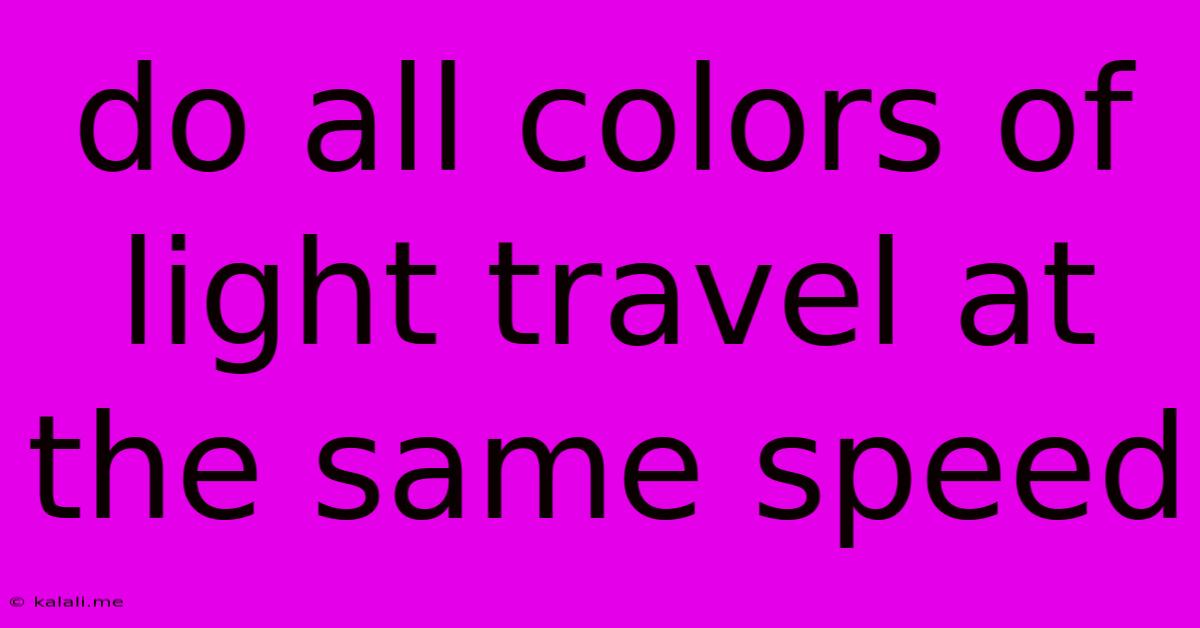Do All Colors Of Light Travel At The Same Speed
Kalali
Jun 06, 2025 · 3 min read

Table of Contents
Do All Colors of Light Travel at the Same Speed?
Meta Description: Discover the fascinating truth about the speed of light and its different colors. We delve into the physics behind light's constant speed, regardless of its wavelength or color. Learn how this fundamental constant impacts our understanding of the universe.
The simple answer is a resounding yes. All colors of light, from the deepest reds to the brightest violets, travel at the same speed in a vacuum. This speed, universally represented as 'c', is approximately 299,792,458 meters per second. This fundamental constant is a cornerstone of Einstein's theory of special relativity and has profound implications for our understanding of the universe.
Understanding the Nature of Light
Before we dive into the specifics, it's important to understand what light actually is. Light is electromagnetic radiation, meaning it's a form of energy that travels as waves. These waves oscillate with varying frequencies, and this frequency determines the color we perceive. Higher frequencies correspond to colors like violet and blue, while lower frequencies correspond to colors like red and orange. The wavelength of light is inversely proportional to its frequency; longer wavelengths mean lower frequencies, and vice-versa.
The Constant Speed of Light in a Vacuum
While the frequency and wavelength of light vary across the electromagnetic spectrum (including visible light, radio waves, X-rays, etc.), the speed of light in a vacuum remains constant. This seemingly paradoxical fact is a fundamental principle of physics. No matter the color (or frequency/wavelength) of light, it will always travel at 'c' in a vacuum.
This constancy is not arbitrary; it's a consequence of the fundamental laws of electromagnetism and special relativity. Einstein's theory postulates that the speed of light is a universal constant, independent of the motion of the observer or the source of the light.
What Happens When Light Passes Through a Medium?
The situation changes slightly when light passes through a medium other than a vacuum, such as air, water, or glass. In these mediums, the speed of light is slower than 'c', and this slowing depends on the refractive index of the medium. Importantly, however, all colors of light are slowed down proportionally. While the speed changes, the relative difference in speed between different colors remains consistent. This is why we observe phenomena like dispersion (the separation of white light into its constituent colors using a prism). Dispersion isn't caused by different colors travelling at different speeds, but rather by their different degrees of refraction within the medium.
Misconceptions and Clarifications
A common misconception is that red light travels faster than blue light. This is incorrect. While red light has a longer wavelength and lower frequency than blue light, both travel at the same speed in a vacuum. The difference in wavelength and frequency only affects how they interact with matter, leading to phenomena like dispersion.
Conclusion
In conclusion, the speed of light in a vacuum is a fundamental constant, independent of its color or wavelength. While the speed of light can be affected by the medium it travels through, all colors are affected proportionally. Understanding this principle is crucial for grasping the complexities of physics and our universe's fundamental workings. The constant speed of light is not just a number; it's a pillar supporting our understanding of space, time, and the nature of reality itself.
Latest Posts
Latest Posts
-
Pitbull Mixed With Bull Terrier Puppies
Jun 06, 2025
-
Hot Water In Shower Not Lasting Long
Jun 06, 2025
-
Will Bug Repellent Keep Bed Bugs Off Me
Jun 06, 2025
-
Fallout 4 Power Armor Repair Cost
Jun 06, 2025
-
A Time And Times And Half A Time
Jun 06, 2025
Related Post
Thank you for visiting our website which covers about Do All Colors Of Light Travel At The Same Speed . We hope the information provided has been useful to you. Feel free to contact us if you have any questions or need further assistance. See you next time and don't miss to bookmark.